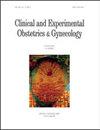交界性卵巢肿瘤患者行卵巢囊肿切除术可行吗?回顾性研究和文献综述
IF 0.6
4区 医学
Q4 OBSTETRICS & GYNECOLOGY
引用次数: 0
摘要
背景:鉴于交界性卵巢肿瘤(BOTs)通常发生在没有生育史的年轻、有生育能力的女性身上,治疗计划中应考虑保留生育能力。本回顾性研究旨在评估BOTs患者卵巢囊肿切除术的安全性。方法:根据手术类型,将2007年8月至2016年8月在我院接受治疗的BOTs患者分为两组:膀胱切除组和卵巢切除术组,无论是否进行输卵管切除术,并比较手术结果的差异。还使用Kaplan–Meier曲线对累积疾病复发进行了比较。结果:在入选的162名患者中,128名(79.0%)接受了卵巢切除术,包括或不包括输卵管切除术,34名(21.0%)接受卵巢囊肿切除术。膀胱切除组的患者比卵巢切除术组的患者年轻(29.2岁对46.5岁,p<0.001),并且膀胱切除组接受微创手术的患者比例高于卵巢切除术(88.2%对46.9%,p<001)。在44个月的平均随访期内,6名患者(3.70%)出现疾病复发(卵巢切除术组和膀胱切除组分别为5名[3.9%]和1名[2.9%])。膀胱切除术和卵巢切除术组的两年无病生存率分别为97.1%和97.6%,两组之间没有差异(p=0.818)。本文章由计算机程序翻译,如有差异,请以英文原文为准。
Is ovarian cystectomy feasible for patients with borderline ovarian tumors? A retrospective study and review of the literature
Background: Given that borderline ovarian tumors (BOTs) are usually found in young, fertile women without a history of childbirth, fertility preservation should be considered in the treatment plan. This retrospective study aimed to evaluate the safety of ovarian cystectomy in patients with BOTs. Methods: Patients with BOTs treated between August 2007 and August 2016 at our institution were divided into two groups according to the type of surgery: the cystectomy group and the oophorectomy group with or without salpingectomy, and differences in surgical outcomes were compared. The cumulative disease recurrence was also compared using Kaplan–Meier curves. Results: Of the 162 patients enrolled, 128 (79.0%) underwent an oophorectomy with or without salpingectomy and 34 (21.0%) underwent an ovarian cystectomy. The patients in the cystectomy group were younger than those in the oophorectomy group (29.2 years vs. 46.5 years, p< 0.001), and the proportion of patients who underwent minimally invasive surgery was higher in the cystectomy group than in the oophorectomy group (88.2% vs. 46.9%, p < 0.001). During the mean follow-up period of 44 months, six patients (3.70%) developed disease recurrence (five [3.9%] and one [2.9%] in the oophorectomy and cystectomy groups, respectively). The two-year disease-free survival rate was 97.1% and 97.6% in the cystectomy and oophorectomy groups, respectively, and did not differ between the groups (p = 0.818). Discussion: Ovarian cystectomy can be considered a safe and effective option for young women with BOTs who wish to preserve their fertility.
求助全文
通过发布文献求助,成功后即可免费获取论文全文。
去求助
来源期刊
CiteScore
0.50
自引率
0.00%
发文量
241
审稿时长
1 months
期刊介绍:
CEOG is an international, peer-reviewed, open access journal. CEOG covers all aspects of Obstetrics and Gynecology, including obstetrics, prenatal diagnosis, maternal-fetal medicine, perinatology, general gynecology, gynecologic oncology, uro-gynecology, reproductive medicine, infertility, reproductive endocrinology, sexual medicine. All submissions of cutting-edge advances of medical research in the area of women''s health worldwide are encouraged.

 求助内容:
求助内容: 应助结果提醒方式:
应助结果提醒方式:


